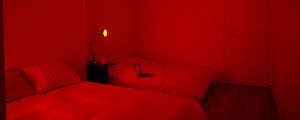“If art is about truth and honesty […] it should flash a light on nowadays (sic.)” Daniel Richter
This idea of light, dark and actuality is exactly what Richter is investigating in his exhibition “Voyage Voyage”, a collection of seven canvases displayed at the Thaddaeus Ropac Gallery in Paris’ Marais district.
Both dark and brightly disturbing, Richter’s canvases give us “common clichés of heroism” thrown into “world of warcraft” (in his own words). This might sound hyperbolic at the least and incongruous at most, but you’ll see immediately what he means once you look at his pieces.

Each painting is less about what words might be used to describe the content (which might or might not render this article void) and more about the process involved. As Richter insists, “you talk about the things you can describe but what makes a painting tick is the way how it’s done […] that’s the dark spot in oneself (sic.)”

The title of the collection has been taken from the eponymous 1987 cult hit by French artist Desireless. Aside from obvious connections to self-discovery, contemplation and escapism, there is also a satirical nod to Richter’s interest in pop culture and the media, which is seen through the theatrics in his work, canvases where movement and topography is a key element of each piece. In an interview recorded for the exhibition, Richter talks about how his paintings are “based on lines”, and you can see how these lines resemble plate tectonics; curving contours building a landscape in flux.
In each piece ghostly figures seep out, often from artificial cliff tops or high points, neon flashes reminding us of Richter’s previous work where he experimented with fluorescents and the purely abstract. It was at the turn of the century that the artist moved onto a more figurative style, but without losing his inspiration from the contemporary and underground spheres (graffiti, pop art, commercial art) that characterise his work. These lime-greens and neon yellows are given a brooding twist when contrasted against a predominantly black, ochre and Prussian blue palette.

My favourite piece in the exhibition is a hard one to choose. They all work well together as a cohesive collection, but equally each canvas has a unique identity. “Rubykomm” really left an impression with its haunting silhouette of a mysterious figure with a rifle patrolling what could be a damn in an equally obscure mountainous landscape. The images stay with you afterwards, colours imprinted onto your memory.
“D.O.A.XL” (2011), with its aggressive post-apocalyptic figures racing towards the foreground is also brilliantly executed, with a singular red glove providing a comic-book reference and giving an unexpected opacity in a scene where everything feels translucent. I felt that this piece was a perfect juxtaposition of the subconscious captured and the product of the imagination realised.
Richter seeks to evoke a “vanishing manlihood (sic.)” through this collection, and it’s true that I was particularly struck by the moment of suspense he captures: you have the impression that these ghostly, yet disturbingly familiar, figures are bleeding into the canvas; a fading watermark of our own dark spot.
(Voyage, Voyage is on @ the Parisian Thaddeus Ropac gallery until July 28th)
















